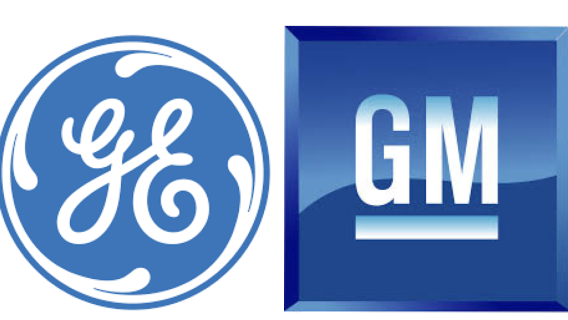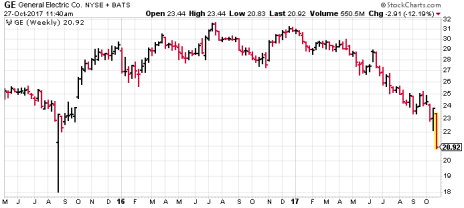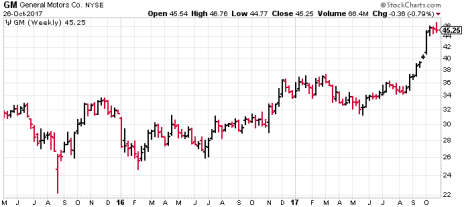General Electric stock and General Motors stock. One of them is a good buy here. But which one?
The two “Generals” are American icons, with General Electric (GE) tracing its roots back to 1892, while General Motors (GM) was founded in 1908.
But it’s the future that investors care about, and today I want to talk about the future for both of these institutions.
General Electric Stock
Right now, investors are worried about GE stock.
The reason: the company’s third-quarter report was massively disappointing. While analysts had expected earnings of 49 cents per share, GE delivered only 29 cents!

Get My Free Report Now

Get My Free Report Now

Get My Free Report Now

Get My Free Report Now
New CEO John Flannery is taking the heat for this, but he’s only been in the position for three months, succeeding Jeffrey Immelt, who held the post for nearly 16 years.
Flannery blames challenges in the power sector as well as divestitures that are impacting cash flow, and he says that by selling roughly $20 billion of business in the next two years, he can achieve a turnaround.
But the stock market is saying otherwise.
Since peaking at 31 last December, GE has been heading down, as institutions have slowly revised their opinions of the company downward. And this is happening in the midst of a great bull market!
At some point, GE stock may become a good value, but from my perspective, the real story that matters today is about momentum and changing perceptions. Every day, institutional money managers are waking up and deciding that they should lighten their holdings of General Electric stock a bit. For a massive holding like this, that takes time.
And every day, no one wakes up and says, “GE, there’s an interesting young company that’s going places!”
In short, selling power continues to outweigh buying power, and thus the downward momentum continues—and there’s no telling how long it will last or how low it will go.
One problem is that today, it’s hard to find a true growth sector in the conglomerate’s diverse portfolio. As of last year, GE derived 22% of its income from power, 21% from aviation, 15% from healthcare, 12% from connections and lighting, 10% from oil and gas and 9% from financial services. There’s nothing there that gets my heart racing.
As to revenues, at $128 billion for the fiscal year, they are down 30% from a decade ago, and destined to shrink even further as Flannery cuts unprofitable divisions.
And with cash flow now weak, the big question is whether the dividend is at risk.
Today, General Electric stock yields 4.5% (and the more the stock falls, the more the yield grows). But if GE’s cash flow gets tight and Flannery finds he has to cut the dividend, watch out below!
General Motors Stock
Right now, no one is worried about General Motors.
Since the 2009 bailout (by U.S. taxpayers) and the 2010 IPO of the reconstituted company, GM has seen revenues stay eerily flat at roughly $150 billion per year.
But earnings trends are positive, and analysts’ estimates are improving. As a result, every day, more and more institutional investors wake up and conclude that they need to add a little more GM to their portfolios.
Furthermore, GM might actually be thought of as cheap.
The company’s PSR (price-to-sales ratio) is just 0.44 (that’s a market cap of $68 billion divided by revenues of $153 billion)—though debt and inventories tend to weigh on automakers.
And looking at earnings, it’s definitely cheap! The current P/E ratio is just 7 and the forward P/E ratio is only 8!
And then there’s the chart action.
For most of this year, GM traded in a range between 32 and 36, but at the end of August, the stock broke out of that trading range to the upside, and the volume on the advance was big!
That rally took the stock from 35 to 45 in a month, and in the few weeks since then, the stock has been trading tightly between 45 and 46.
Conclusion: there’s no selling power here, and thus GM is destined to move higher.
Thus, if I had to buy one of these stocks, I’d definitely buy GM.
But an even better idea would be to become a regular reader of Cabot Dividend Investor, because that’s where Chief Analyst Chloe Lutts Jensen recommended GM stock way back in August 2015 when the stock was trading at 32. Today, her readers are not only sitting on profits of 48%, they’re looking at a yield on cost (based on their original purchase price) of 4.8%!
And that’s not their only winner. Chloe’s readers have profits exceeding 50% in three low-risk dividend-paying stocks. Overall, her three portfolios show an average profit of 21% and an average yield of 3.5%.
If current income from low-risk dividend-paying stocks is your goal, you need to join Chloe’s readers today.
To get started, click here.
But don’t delay. Act today, while the bull market is alive and well!







